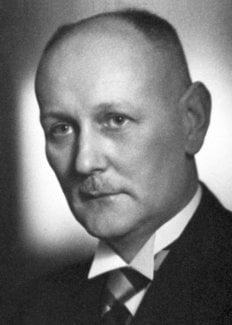Gerhard Domagk
Biographical

Gerhard Johannes Paul Domagk was born on October 30, 1895, at Lagow, a beautiful, small town in the Brandenburg Marches. Until he was fourteen he went to school in Sommerfeld, where his father was assistant headmaster. His mother, Martha Reimer, came from farming stock in the Marches, where she lived in Sommerfeld until 1945 when she was expelled from her home; she died from starvation in a refugee camp.
Domagk himself was, from the age of 14, at school in Silesia until he reached the upper sixth form. He then became a medical student at Kiel and, when the 1914-1918 War broke out, he served in the Army, and in December 1914 was wounded. Later he was sent to join the Sanitary Service and served in, among other places, the cholera hospitals in Russia. During this time he was decisively impressed by the helplessness of the medical men of that time when they were faced with cholera, typhus, diarrhoeal infections and other infectious diseases. He was especially strongly influenced by the fact that surgery had little value in the treatment of these diseases and even amputations and other forms of radical treatment were often followed by severe bacterial infections, such as gas gangrene.
In 1918 he resumed his medical studies at Kiel and in 1921 he took his State Medical Examinations and graduated. He undertook laboratory work under Max Bürger on creatin and creatinin, and later metabolic studies and analysis under Professors Hoppe-Seyler and Emmerich.
In 1923 he moved to Greifswald and there became, in 1924, University Lecturer in Pathological Anatomy. In 1925 he held the same post in the University of Münster and in 1958 became professor of this subject. During the years 1927-1929 he was, however, given leave of absence from the University of Münster to do research in the laboratories of the I.G. Farbenindustrie, at Wuppertal. In 1929 a new research institute for pathological anatomy and bacteriology was built by the I.G. Farbenindustrie and there, in 1932, Domagk made the discovery for which his name is so well known, the discovery that earned him the Nobel Prize in Physiology or Medicine for 1939, namely, the fact that a red dye-stuff, to which the name «prontosil rubrum» was given, protected mice and rabbits against lethal doses of staphylococci and haemolytic streptococci. Prontosil was a derivative of sulphanilamide (p-aminobenzenesulphonamide) which the Viennese chemist, Gelmo, had synthesized in 1908.
Domagk was, however, not satisfied that prontosil, so effective in mice, would be equally effective in man, but it so happened that his own daughter became very ill with a streptococcal infection, and Domagk, in desperation, gave her a dose of prontosil. She made a complete recovery, but Domagk omitted mentioning the recovery of his daughter from the report on the effect of the drug, waiting until 1935 when results were available from clinicians who had tested the new drug on patients. During subsequent years much work was done in various countries on this class of antibacterial compound and some thousands of derivatives of sulphanilamide have been produced and tested for their antibacterial properties. Domagk’s work has thus given to medicine, and also to surgery, a whole new series of weapons that are effective against many infectious diseases.
The discovery of the antibacterial action of the sulphonamides was not, however, Domagk’s only contribution to chemotherapy. He also discovered the therapeutic value of the quaternary ammonium bases and he also extended, in collaboration with Klarer and Mietzsch, his work on the sulphonamides. Later, he attacked the problem of the chemotherapy of tuberculosis, developing for this the thiosemicarbazones (Conteben) and isonicotinic acid hydrazide (Neoteben). His work has undoubtedly resulted in more effective control of many infectious diseases which nowadays have lost the terrors they formerly caused. The supreme aim of chemotherapy is, in Domagk’s opinion, the cure and control of carcinoma and he was convinced that this will be, in the future, achieved.
Domagk held honorary doctorates of the Universities of Bologna, Münster, Cordoba, Lima, Buenos Aires, and Giessen. He was made Knight of the Order of Merit in 1952, was awarded the Grand Cross of the Civil Order of Health of Spain in 1955. Other honours and distinctions bestowed upon him were: Paul Ehrlich Gold Medal and Paul Ehrlich Prize, University of Frankfurt (1956); Foreign Member of the British Academy of Science and of the Royal Society (1959); Honorary Member of the German Dermatological Society (1960); Japanese Order of Merit of the Rising Sun (1960).
In 1925 Domagk married Gertrud Strübe. They had three sons and one daughter.
Retiring to his old university of Münster, when laboratory work was no longer possible for him, he had devoted himself to the experimental (chemotherapeutic) study of carcinoma and to the dissemination of modern knowledge about it among the students and others interested in it. His recreation was painting.
Dr Domagk died on April 24, 1964.
This autobiography/biography was written at the time of the award and first published in the book series Les Prix Nobel. It was later edited and republished in Nobel Lectures. To cite this document, always state the source as shown above.
Nobel Prizes and laureates
Six prizes were awarded for achievements that have conferred the greatest benefit to humankind. The 12 laureates' work and discoveries range from proteins' structures and machine learning to fighting for a world free of nuclear weapons.
See them all presented here.

